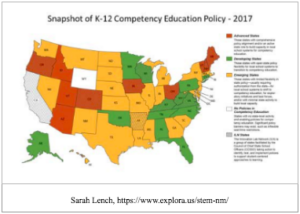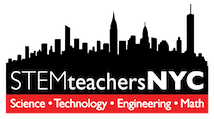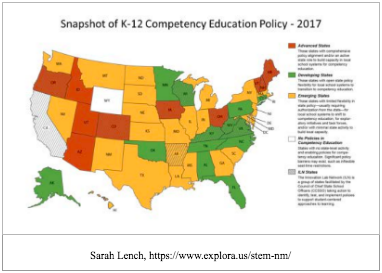“Learning is not a competition.”
Use of alternative assessments in interdisciplinary STEM classrooms is gradually expanding and being refined. Who are you learning from and what is working for you? In this blog post we explore the idea of Standards-Based Grading in STEM, and the importance of developing alternative assessments to meet the needs of all learners in the science and math classroom.
 How did education become so focused on competition, competition based on testing that attempts to compare students, schools, and countries with highly diverse experiences, histories, and education systems? The mandate to use standardized testing to define “success” continues to play a role. But the translation of cross-curricular and project-based learning into identifiable rubrics around engagement, skills, content, and competency in application poses challenges.
How did education become so focused on competition, competition based on testing that attempts to compare students, schools, and countries with highly diverse experiences, histories, and education systems? The mandate to use standardized testing to define “success” continues to play a role. But the translation of cross-curricular and project-based learning into identifiable rubrics around engagement, skills, content, and competency in application poses challenges.
“In an inquiry approach, we will ask children, how do you find out the area of the field, and have them discuss and brainstorm. This may take more time, but pupils are “more likely to remember and enjoy the lesson”. Sound familiar? These are the words of Ong Ye Kung, Singapore’s Education Minister. After years of success in attaining high scores on international tests, Singapore’s Ministry of Education (MOE) is making a major shift away from competitive assessments and high stakes grading, with the goal of reorienting student thinking toward personal growth and lifelong learning.
The changes are intended to “give teachers more space to explore new ways of making learning enjoyable and lasting. “On the ground, teachers are on a high-speed train… rushing, assessments and preparing the students for exams… I think it is time to take a pause.” “Discussions, homework and quizzes are set to replace marks and grades as the preferred method of collecting information on the performance of young primary school pupils. Starting in 2019, exams for primary years 1 and 2 students will be abolished.”
This does not mean that assessments won’t take place, and the key underlying change and challenges will center on a new system of assessment, and supporting teachers in creating a reliable framework. In the US, points-based systems sharply contrast with a more holistic, comprehensive, student-led system. With global trends in STEM job skills moving from technology usage to design, from awareness, precision and management, to active learning, creativity, complex problem solving and systems thinking, our assessment systems must adapt.
What tools already exist?
This summer Mark Schober, Manjula Nair, and Emily Wheeler will be bringing back their Assessment and Standards Based Grading in STEM workshop, developed from their own extensive work refining a student-owned framework. The process and goals of such a transition from Points-Based Grading to Standards-Based Grading (SBG), are to move from providing feedback to students on disconnected content not-relevant to their lives or growth, to making connections to broader learning objectives. So what is Standards-Based Grading anyway? “Rather than rating student performance on a quiz or test in terms of points or a percentage, let students know how well their work met the objectives. The approach may incorporate:
- Give students metacognitive opportunities to consider for themselves how well their work met the objectives.
- Keep the rating system simple, especially when starting out. (Three level scale: proficient, learning, unable to assess. Four level scale: exceeds target, meets target, partially meets target, unable to assess.)
- If a student is absent for an assessment or unable to attempt an answer, the rating is “unable to assess”. No proficiency is earned, and the student prepares to assess again in order to demonstrate their understanding.
- Students can mark up their own assessments, recording feedback that is useful to them and getting instant feedback on their work. When students finish their quizzes… [they] make corrections, [make] meaningful notes to themselves [and] self-rate how they think they did in terms of the learning objectives. The teacher then adds any comments that the students may have missed and provides their rating of the student work.”
From sibling STEM fields:
For instance, on maintaining and measuring engagement, from Christa Flores at the FabLab at Stanford:
“Although new methods for assessing meaningful work and learning through projects are emerging, take Maker portfolios now accepted at MIT for example, we are still working primarily within a grade-based system. “Student driven learning would entail students having a degree of choice in the content they will study, the skills they will be building or the assessment used to illustrate their learning. Some combination of teacher and student centered learning is more likely the typical experience…” After the [learning activity] takes place, the learner processes the outcome or consequences of their actions through two filters; their cognitive self and their emotional self. The cognitive self seeks to diagnose the reason for the failure or the success… The emotional self fills a vital role at this point [engagement or motivation]. When the learner is removed from the critical assessment process… they are left with how they feel about a success or failure, but are not encouraged to take part in the empowering aspect of constructing the causal relationships between their actions and their successes or failures. Removing the cognitive from the emotional, for both learner and teacher, creates an imbalance…”
“As the research strongly suggests,” states Mariale Hardiman, professor of education at the Johns Hopkins University School of Education, “when students focus on mastery of learning rather than on their performance on tests, they significantly increase their intrinsic motivation for learning.”
Some additional resources:
- The informal formative assessment ESRU cycle (teacher Elicits, Student responds, teacher Recognizes, teacher Uses the information to modify lesson), and strategic dialogue.
- In a mastery based assessment system “students are expected to take responsibility for meeting the school’s expectations. Rubrics are transparent to the students so that they know exactly what is required of them. Teachers provide the instructional support students need and make themselves available for additional help, but students are expected to know their own status and be proactive about seeking what they need, whether from teachers, tutors, or fellow students.”
- Help students build their own learning progressions or progress maps, whether at the beginning of the year or the end of the year, students can visualize and track their own learning.
- Incorporating measures of engagement within a STEM rubric.
- Adaptive items, performance tasks, and ways for students to teach each other and predicting questions from peers can also play a role in an alternative assessment toolkit.
Alternative Assessments in STEM is one of several new virtual STEMteachersNYC Working Groups we’ll be floating this summer, linked to themes from our Summer Institute workshops. Join the conversation! Share what you’re doing or what sub-topics you would like to dive into… and keep and eye out for the working group launch!

